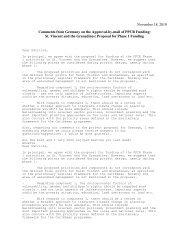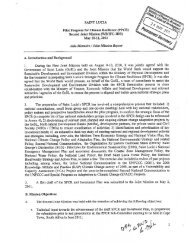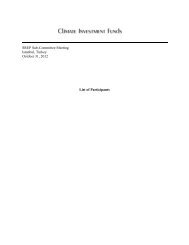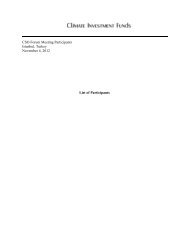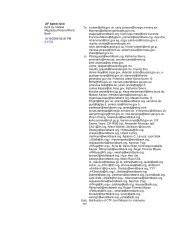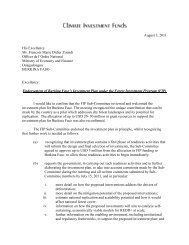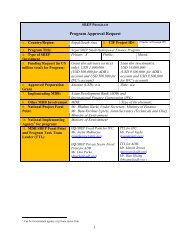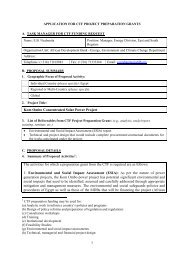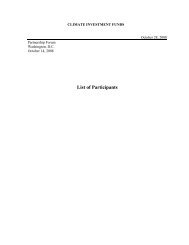(psp) in the peruvian drinking - Climate Investment Funds
(psp) in the peruvian drinking - Climate Investment Funds
(psp) in the peruvian drinking - Climate Investment Funds
You also want an ePaper? Increase the reach of your titles
YUMPU automatically turns print PDFs into web optimized ePapers that Google loves.
PRIVATE SECTOR PARTICIPATION (PSP) IN<br />
THE PERUVIAN DRINKING WATER<br />
SECTOR: THE ECONOMIC REGULATOR<br />
EXPERIENCE<br />
2011 CIF Partnership Forum Session<br />
“Tapp<strong>in</strong>g growth potential <strong>in</strong> climate change through<br />
<strong>in</strong>novative partnerships”<br />
José SALAZAR BARRANTES<br />
President<br />
SUNASS – PERÚ<br />
jsalazar@sunass.gob.pe<br />
June 24, 2011 Cape Town, South Africa<br />
CA MacroWatch
INDEX<br />
1. THE PERUVIAN SETTING<br />
2. PSP IN THE PERUVIAN DRINKING WATER AND<br />
SANITATION SECTOR<br />
3. WINDOWS OF OPPORTUNITIES, KEY FACTORS FOR<br />
ATTRACTING PSP, RECOMMENDATIONS FOR<br />
PRIVATE OPERATORS<br />
2
THE PERUVIAN SETTING:<br />
why Peru is so attractive to<br />
3<br />
private <strong>in</strong>vestments?
CLEANER ECONOMIC GROWTH WITH SOCIAL-EQUITY<br />
Real Growth Rate<br />
1992-2010 (% year variation )<br />
Opportunity: Invest<strong>in</strong>g <strong>in</strong> water source conservation to susta<strong>in</strong> its economic growth,<br />
because <strong>the</strong>re is no technological substitute to dr<strong>in</strong>k<strong>in</strong>g water.<br />
4
PERU IS THE LARGEST WATER SOURCE IN THE ANDEAN<br />
REGION, BUT….<br />
SUPERFICIE, POBLACIÓN, PBI, Y DISPONIBILIDAD<br />
DE AGUA POR REGIÓN,<br />
año 1996<br />
%<br />
100.0<br />
80.0<br />
60.0<br />
40.0<br />
20.0<br />
0.0<br />
21.8<br />
74.6<br />
70.0<br />
26.0<br />
Cities and <strong>in</strong>dustries are<br />
localed <strong>in</strong> arid lands.<br />
Pacifico Atlántico Titicaca<br />
80.4<br />
17.7<br />
97.7<br />
3.7 4.0 1.9 1.8 0.5<br />
Superficie Poblacion PBI Disponibilidad<br />
de Agua<br />
Mismatch: hydro-map, demo-map and GDP-map. Match: poverty-map, water-sourcesmap,<br />
natural-disaster-map, biodiversity-map. A new social deal is required to armonise<br />
<strong>the</strong>se maps under a governance approach
UNIVERSAL ACCESS TO DRINKING WATER–SANITATION<br />
SUPPLY IN PERU: an opportunity for PPP<br />
NATIONAL COVERING<br />
MILLENIUM<br />
DEVELOPMENT GOALS<br />
Goal 7: Ensure<br />
environmental susta<strong>in</strong>ability<br />
NATIONAL<br />
AGREEMENT<br />
By 2015, reduce by half <strong>the</strong><br />
proportion of people without<br />
susta<strong>in</strong>able access to safe<br />
dr<strong>in</strong>k<strong>in</strong>g water<br />
COMMITMENTS<br />
Expansion of <strong>the</strong> coverage of<br />
dr<strong>in</strong>k<strong>in</strong>g water and sanitation<br />
supply.<br />
Improve <strong>the</strong> dr<strong>in</strong>k<strong>in</strong>g water and<br />
sanitation <strong>in</strong>fraestructure<br />
URBAN ZONE<br />
RURAL ZONE<br />
GOVERNMENT<br />
POLICY<br />
13 C<br />
21 C<br />
Fuente: Dirección Nacional de Saneamiento, Marzo 2010<br />
6
� 3,006,478 Dr<strong>in</strong>k<strong>in</strong>g water connections � 50<br />
WUC (1,285,348 � SEDAPAL)<br />
� 2,695,480 sewage connections � 50 WUC<br />
(1,221,081 � SEDAPAL)<br />
WUC are classified by size:<br />
Medium<br />
UC; 16%<br />
Big UC; 38%<br />
Small UC;<br />
3%<br />
DRINKING WATER - Informe SANITATION de Gestión 2007-2011<br />
UTILITY COMPANIES (WUC) IN PERU<br />
• 50 WUC UNDER SUNASS REGULATION<br />
WUC Quantity Nº connections<br />
SEDAPAL 1 >1,000,000.<br />
EPS GRANDES 11 40,000 - 200,000.<br />
EPS MEDIANAS 23 10,000 - 40,000.<br />
EPS PEQUEÑAS 15 < 10,000 .<br />
SEDAPAL,<br />
43%<br />
WUC TOTAL 50<br />
SEDAPAL 1<br />
Big UC 12<br />
Medium UC 22<br />
Small UC 15
MEF<br />
MVCS<br />
O<strong>the</strong>r m<strong>in</strong>istries<br />
DNEP DNPP DNS APT<br />
Health Environment<br />
Agreements<br />
Foreign Debt<br />
COLFONAVI<br />
SUNASS<br />
Professional<br />
Association<br />
Chamber of<br />
Commerce<br />
DRINKING WATER – SANITATION SECTOR:<br />
PERUVIAN STAKEHOLDER MAP<br />
Autonomus agencies<br />
& Private Associations<br />
Budget for watersanitation<br />
programmes<br />
Local Debt<br />
Tariff/<br />
<strong>Investment</strong>s<br />
Member of <strong>the</strong> board<br />
Member of <strong>the</strong> board<br />
Policy and<br />
Strategic<br />
Plann<strong>in</strong>g<br />
Water Utility<br />
Company<br />
(EPS)<br />
Donations,<br />
subsidies<br />
Member of <strong>the</strong> board<br />
Operation<br />
contract<br />
Quality of<br />
Dr<strong>in</strong>k<strong>in</strong>g Water<br />
Local Government<br />
Prov<strong>in</strong>cia District<br />
2 Members of <strong>the</strong> Board<br />
Regional Goverment<br />
Budget<br />
appropiations<br />
Waste Water<br />
Discharges
SUNASS-REGULATOR´s Informe ROLE: de Gestión urban 2007-2011 areas<br />
FUNCTIONS<br />
Controversy and<br />
compla<strong>in</strong>t solutions<br />
Law, regulation,<br />
standards<br />
Tariff Regulation<br />
SUNASS<br />
Audit<strong>in</strong>g and<br />
sanction<br />
Supervision<br />
GOALS-PUBLIC POLICY: Universal access and operator susta<strong>in</strong>ability
ALBERTO FUJIMORI<br />
PRESIDENT<br />
SUPERINTENDENTES-oneperson<br />
May 1994 to january 2001<br />
Appo<strong>in</strong>ted wiithout public<br />
tender<br />
There was no Board of<br />
Directors<br />
03 Super<strong>in</strong>tendents<br />
STRONG REGULATORY INSTITUTIONALITY:<br />
THE SUNASS CASE<br />
If you want PSP <strong>in</strong> <strong>the</strong> public utilities bus<strong>in</strong>ess, you need a strong regulator..!!<br />
ALEJANDRO TOLEDO<br />
PRESIDENT<br />
Appo<strong>in</strong>ted as a result of a public<br />
tender<br />
Board od Directors: 5 experts,<br />
where 4 experts are appo<strong>in</strong>ted<br />
without public tender<br />
ALAN GARCIA<br />
PRESIDENT<br />
PRESIDENT-Board-Directors PRESIDENT-Board-Directors<br />
January 2001 to February 2007 February 2007 a February 2012<br />
Appo<strong>in</strong>ted as a result of a<br />
public tender<br />
Renovation of each<br />
member of <strong>the</strong> board by<br />
public tender<br />
SUNASS is an <strong>in</strong>dependent, autonomous and meritocratic agency. All members of <strong>the</strong><br />
board are chosen after a national public contest, with transparency.
NEW REGULATORY VALUE CREATION APPROACH<br />
FOR ACHIEVING PUBLIC POLICY GOALS WITH EFFICIENCY<br />
GENERATING POLITICAL<br />
CONSENSUS WITH CIVIC<br />
LEADERS IN DRINKING WATER<br />
NEW SOCIAL DEAL (city-rural),<br />
INTER-INTRA-GENERATIONAL<br />
BROKER OF CONFIDENCE<br />
11<br />
BUSINESS-IDENTIFICATION,<br />
FINANCIAL-ENGINEERING,<br />
DEAL MAKER-BREAKER, RISK<br />
MITIGATOR, ANCHOR-ALLY<br />
GOVERNABILITY<br />
ECONOMIC-<br />
FINANCIAL-<br />
EFFICIENCY<br />
ARTICULATION<br />
ENFORCEMENT-ENHANCER,<br />
COACHING-PLAYERS,<br />
BROKER OF CONFIDENCE<br />
ENVIRONMENTAL<br />
CONSERVATION<br />
CONSERVATION-FINANCE,<br />
LEADER-INNOVATION<br />
INVESTMENT-ACCELERATOR,<br />
CREATING-MOMMENTUM,<br />
MATCH-MAKING BUSINESS,<br />
REDUCING TRANSACTION<br />
COSTS
Collect<strong>in</strong>g<br />
Treatment<br />
Storage/<br />
Distribution<br />
Recolection<br />
Disposal<br />
REGULATORY MASTER INSTRUMENT: PLAN MASTER PLAN<br />
IMPROVING BENCHMARKING: <strong>in</strong>dicators of service quality and tariff levels,<br />
subject to f<strong>in</strong>anc<strong>in</strong>g availability and population-payment-capacity<br />
Management goals<br />
Quality of service<br />
Estimated Supply and Demand<br />
Infrastructure gap<br />
<strong>Investment</strong> Programme<br />
Technical–Economic Evaluation<br />
Estimated Operational Cost Efficient<br />
F<strong>in</strong>al<br />
<strong>Investment</strong>s<br />
Technical SolutionS<br />
� Siz<strong>in</strong>g<br />
� Efficient costs<br />
� Schedul<strong>in</strong>g<br />
Tariff Formula &<br />
Tariff structure
EVOLUTION OF SUNASS INSTRUMENTS:<br />
INCORPORATING P.E.S. & RESILIENCE PRICES<br />
+<br />
LAW FRAMEWORK<br />
• General law of<br />
dr<strong>in</strong>k<strong>in</strong>g water –<br />
sanitation service.<br />
• General Law<br />
Regulation.<br />
• Concepts of master<br />
plan and f<strong>in</strong>anc<strong>in</strong>g<br />
plan<br />
UTILITY COMPANY<br />
ADAPTATION<br />
• Order<strong>in</strong>g <strong>the</strong><br />
• Implementation of<br />
system tariffs: 1st<br />
phase.<br />
• Conceptual design<br />
of master plan.<br />
• Regulatory<br />
functions<br />
regulation.<br />
MASTER PLAN<br />
STRENGTHENING<br />
• 31 MP approved.<br />
• Payment for<br />
Environmental<br />
Services and<br />
crossed subsides.<br />
• Manual and<br />
plann<strong>in</strong>g<br />
Regulatory<br />
Account<strong>in</strong>g.<br />
• ISO 9001:2008.<br />
• Governability.<br />
• Risk efficient<br />
approaches<br />
1994-2001 2002-2006 2007-2010<br />
+<br />
+<br />
RESILIENCE<br />
• Prospective vision to<br />
30 years for<br />
susta<strong>in</strong>ability of<br />
system, <strong>in</strong>clud<strong>in</strong>g risk<br />
management and<br />
climate change.<br />
• Improv<strong>in</strong>g resources<br />
use of utility<br />
companies <strong>in</strong>clud<strong>in</strong>g<br />
risk economic value.<br />
• Includ<strong>in</strong>g <strong>in</strong> tariff<br />
resilience prices for<br />
natural disasters.<br />
2011 -…..
NEW PARADIGM FOR SUSTAINABLE REGULATION<br />
2+2 = 6<br />
2+2 = 8<br />
2+2 = 10<br />
Ecological economics<br />
Environmental economics<br />
Natural resource economics<br />
Market economy<br />
DD<br />
2+2 = 4 PMO economics<br />
2<br />
2+2 = 12<br />
Industrial ecology<br />
New tools and techniques for valu<strong>in</strong>g eco-services provided by nature<br />
29/06/2011 14 version 1.4.<br />
Eco-good / service<br />
Regulatory<br />
4<br />
6<br />
8
GREENING ECONOMIC REGULATION OF DRINKING WATER AND<br />
SANITATION SERVICES IN PERU<br />
Environmental economics Regulatory economics<br />
Indirect value<br />
Environmental good<br />
Natural water<br />
Environmental service<br />
Water cycle<br />
AVOIDED COST APPROACH<br />
Eco-<strong>in</strong>fraestructurE<br />
Wetlands, manglares,<br />
bofedales, aguajales,<br />
bosques relictos, bosques<br />
secos, pajonales, paramos,<br />
etc.<br />
SUNASS<br />
VALUE<br />
COST<br />
PMO<br />
SUSTAINABLE<br />
TARIFF<br />
Direct value<br />
Economic good<br />
Dr<strong>in</strong>k<strong>in</strong>g water<br />
Public service<br />
Potabilization and sanitation<br />
COSTOS EFFICIENT APPROACH<br />
Eng<strong>in</strong>eer<strong>in</strong>g Infraestructure<br />
Dams, potabilization plants,<br />
networks, pipel<strong>in</strong>es, aquifers<br />
recharge, etc.<br />
Regulator: speak<strong>in</strong>g <strong>in</strong> different languages (regulatory, legal,<br />
environmental, economic, f<strong>in</strong>ancial, bus<strong>in</strong>ess, etc.)<br />
15
INSTRUMENT-TOOL AREA OBJETIVES<br />
MASTER PLAN<br />
TARIFF<br />
REGULATION<br />
OFFICE-GRT<br />
INVESTMENT PLAN PRIORIZED AND FINACED FOR 30 YEARS<br />
MODELING TARIFF SCENARIOS DEVELOPED FOR MASTER PLAN.<br />
TARIFF COACHING UTILITY COMPANY STAFF TRAINNING IN MASTER PLAN USE.<br />
CROSS SUBSIDIES POOR PEOPLE EAR-MARKED TARIFF<br />
PAYMENT FOR<br />
ENVIRONMENTAL<br />
SERVICE<br />
UTILITY COMPANY WATER SOURCE CONSERVATION, FLOWS<br />
REGULATION, POLLUTION WATER SOURCE REDUCTION.<br />
REARRANGEMENT SIMPLIFY TARIFFS FOR CONSUMERS<br />
EFFICIENT COSTING<br />
POLLUTION DISCHARGE<br />
TARIFF<br />
REGULATORY<br />
ACCOUNTING<br />
COURT CONCILIATION ADMINISTRATI<br />
VE<br />
VIRTUALS COURTS<br />
COMPLAINT<br />
RESOLUTION<br />
TRIBUNAL-<br />
FILES DIGITALIZATION TRASS<br />
Fuente: Salazar, J. 2009<br />
NEW TOOL BOX …1<br />
INCORPORATING ECONOMIC EFFICIENCY CRITERIA IN UTILITY<br />
COMPANY MANAGEMENT.<br />
PENALIZE TO POLLUTERS AND AWARD TO COMPANIES THAT<br />
TREAT ITS DISCHARGES<br />
GET IN ORDER ITS BOOKKEEPING WITH THE TARIFF MODEL.<br />
STRENGTH THE RELATION AND CONFIDENCE BETWEEN<br />
CONSUMER –UTILITY COMPANY<br />
AT NATIONAL AND VIRTUAL SCOPE, STRENGTH THE RELATION<br />
BETWEEN CONSUMER AND UTILITY COMPANY THROUGH<br />
REGULATOR<br />
TRANSPARENT, REDUCING TRANSACTION-COSTS, ALLOWING<br />
DIRECT ACCESS TO ITS FILE, ON-LINE.<br />
16
INSTRUMENT AREA OBJETIVE<br />
MANAGEMENT AGREEMENT<br />
SUPERVISION &<br />
FISCALIZATION<br />
OFFICE<br />
INCENTIVE GOAL-ACCOMPLISHMENT IN SHORT TERM BEFORE IT IS<br />
PENALIZED<br />
COMMITMENT ACT TOOL FOR GOALS ACCOMPLISHMENT IN LONG TERM.<br />
OPERATION CONTRACT<br />
PROFESSIONAL DIRECTORY<br />
BENCHMARKING<br />
ELECTRONIC NOTIFICATION<br />
STAKEHOLDERS<br />
IDENTIFICATION<br />
THEMATIC LEADERSHIP<br />
MICRO/MACRO-COURT<br />
CONSUMERS<br />
OFFICE<br />
EXECUTING THE TERMS OF THE PROVISION OF PROVINCIAL<br />
MUNICIPALITY AND DEPOLITICIZED.<br />
PROFESSIONAL BOARD OF DIRECTORS FOR A EFFICIENT UTILITY<br />
COMPANY MANAGEMENT<br />
IMPROVE UTILITY COMPANY MANAGEMENT BASED ON COMPARISONS<br />
BETWEEN UTILITY COMPANIES.<br />
SPEED UP REGULATOR RESPONESES TO CONSUMERS AND UTILITY<br />
COMPANIES.<br />
IMPROVE THE RELATION BETWEEN CONSUMERS AND UTILITY<br />
COMPANIES<br />
EMPOWER CIVICS LEADERS IN EACH LOCALITY TO CREATE A DIRECT<br />
LINK BETWEEN CONSUMER AND REGULATOR.<br />
POPULATION INFORMAL APPROVAL OF UTILITY COMPANY MASTER<br />
PLAN AND NEW TARIFF SETTING: LEGITIMACY OF PRICING.<br />
FOCUS GROUP EFFICIENT-DECISIONS BASED ON ACCURATE INFORMATION.<br />
SOCIAL-NETWORKS IN<br />
INTERNET, VIRTUAL FORUMS<br />
CONSUMER COUNCIL NET<br />
NEW TOOL BOX…2<br />
USE NEWS INTERNET SPACES (FACEBOOK, TWITTER) TO CONNECT<br />
CONSUMERS, UTILITY COMPANY AND REGULATOR.<br />
CONECT ORGANIZED CIVIL SOCIETY WITH UTILITY COMPANY AND<br />
REGULATOR, AT MACRO SCALE.<br />
MUNDO SUNASS<br />
ELECTRONIC MAGAZIN<br />
SHARING THE REGULATOR EXPERIENCES WITH STAKEHOLDERS<br />
STAFF, CONSUMER,<br />
UNIVERSITY TRAINING<br />
AQUA EDUCATION<br />
INVOLVE CIVIL SOCIETY, TRAINING WATER LEADERS<br />
17<br />
CULTURAL CHANGE FOCUSED ON CHILDREN, VIA EDUCATION-MINISTRY<br />
Fuente: Salazar, J. 2009
SUNASS GLOBAL ALLIANCES FOR THE XXI CENTURY<br />
INTERNATIONAL<br />
COOPERATION<br />
GOOD IDEAS, GOOD ALLIANCES= SUCCESS<br />
NGO<br />
18<br />
UNITED NATIONS<br />
DEVELOPMENT<br />
BANKS<br />
DRINKING WATER<br />
REGULATORS<br />
18<br />
COOPERATION<br />
SOUTH-SOUTH
PSP IN THE PERUVIAN<br />
DRINKING WATER AND<br />
SANITATION SECTOR: How<br />
SUNASS can create more value<br />
for <strong>the</strong> user and <strong>the</strong> operator?<br />
19
KEY FACTORS FOR ATTRACTING PRIVATE OPERATORS<br />
AND INVESTORS IN PERU, a<br />
1.- Sound macro-economic fundamentals: high GDP growth, low <strong>in</strong>flation, low devaluation,<br />
strong local currency, no fiscal deficit, low debt/GDP ratio, surplus of trade-balance, grow<strong>in</strong>g<br />
<strong>in</strong>ternational reserves and <strong>in</strong>vestment grade status (recognized by S&P, Moody`s and Fitch IBCA).<br />
2.- Political stability: 31 years of democracy (from 1980, 7 governments <strong>in</strong>clud<strong>in</strong>g <strong>the</strong> new one<br />
start<strong>in</strong>g 2011), poverty reduction and alleviation strategies, descentralisation of power <strong>in</strong> progress,<br />
human rights enforcement, etc.<br />
3.- Strong regulatory <strong>in</strong>stitutionality: <strong>the</strong> central bank and bank<strong>in</strong>g regulators are <strong>the</strong> best of <strong>the</strong><br />
LAC region accord<strong>in</strong>g to <strong>the</strong> IMF. The economic-sector-regulators are recognized by its peers as<br />
<strong>the</strong> model for <strong>the</strong> region.<br />
4.- Open economy: As Peru has signed FTA (Free Trade Agreements with <strong>the</strong> USA, Ch<strong>in</strong>a, Japan,<br />
Korea, S<strong>in</strong>gapur, European Union), foreign companies are <strong>in</strong>vest<strong>in</strong>g <strong>in</strong> Peru for export<strong>in</strong>g. Brasil<br />
decided to jo<strong>in</strong> <strong>the</strong> APEC market us<strong>in</strong>g Peru as its bio-oceanic two-way-path, <strong>in</strong>vest<strong>in</strong>g <strong>in</strong> three<br />
cont<strong>in</strong>ental high-ways and a tra<strong>in</strong>.<br />
5.- Regional hub for airl<strong>in</strong>es and sea-shipp<strong>in</strong>g: because of its geographical location and pacific<br />
ocean currents, it is reduc<strong>in</strong>g transaction costs for do<strong>in</strong>g bus<strong>in</strong>ess (Peru´s rak<strong>in</strong>g is No 36 at <strong>the</strong><br />
World Bank report). This is capitalised on <strong>the</strong> IRSA (LAC <strong>in</strong>tegration network) strategy, <strong>the</strong> andean<br />
community <strong>in</strong>tegration process, among o<strong>the</strong>rs.
KEY FACTORS FOR ATTRACTING PRIVATE OPERATORS<br />
AND INVESTORS IN PERU, b<br />
6.- Local capital market expansion: <strong>the</strong> Lima stock exchange grew 50 times <strong>in</strong> 20 years and is<br />
<strong>in</strong>tegrated with Chile-Colombia, l<strong>in</strong>ked to <strong>the</strong> NYSE; sound pension fund system with US$ 30 billion<br />
eager to <strong>in</strong>vest <strong>in</strong>frastructure projects.<br />
7. Legislation promot<strong>in</strong>g private participation: PPP law of 2008 and many bilateral <strong>in</strong>vestment<br />
treaties <strong>in</strong> place and tax regimes. Independence of powers for conflict resolution.<br />
8. Mega-biodiversity-ethnic country: It is key for <strong>the</strong> environmental community, for <strong>the</strong> foodsecurity-pharmaceutical-tourism<br />
<strong>in</strong>dustry, that is support<strong>in</strong>g humank<strong>in</strong>d survival on planet earth.<br />
9. Regional source of dr<strong>in</strong>k<strong>in</strong>g water: The Andean mounta<strong>in</strong>s are natural-water-sources, which<br />
generate clean hydro-energy. So to expand Peru-GDP potential is not limited by water-energy.<br />
10. Qualified local professionals: meet<strong>in</strong>g high <strong>in</strong>ternational standards, hard-workers, knowledge<br />
of <strong>in</strong>tercultural dialogue, good network of contacts, capacity of adaptation to change.<br />
The synergetic comb<strong>in</strong>ation of <strong>the</strong>se factors is mak<strong>in</strong>g Peru, <strong>the</strong> land of opportunities<br />
for PPP (e.g., m<strong>in</strong><strong>in</strong>g, oil, energy, agro-<strong>in</strong>dustry, tourism, tele-com, water, etc.)
HOW PSP CAN CREATE MORE VALUE FOR WATER-<br />
UTILITY-COMPANIES and THE SOCIETY<br />
• Questions for local policy-decision makers:<br />
– Can PSP provide fund<strong>in</strong>g for reduc<strong>in</strong>g <strong>the</strong><br />
<strong>in</strong>frastructure gap? Can carbon f<strong>in</strong>ance catalyze<br />
more capital and reduce transaction costs?<br />
– Can PSP provide management expertise for secur<strong>in</strong>g<br />
a top quality of service?<br />
– Can PSP recover <strong>the</strong> user-citizen confidence on its<br />
water utility company?<br />
– If so, what can we do to maximize this opportunity?<br />
22
Management Types<br />
PSP MODELS FOR PARTICIPATORY-PPP IN PERU<br />
Public Mixed Private<br />
Public company<br />
Autonomus<br />
Public<br />
Adm<strong>in</strong>istration<br />
(Direct management)<br />
Source: Alonso E., AQUAFED<br />
23<br />
Mixed company<br />
Management contracts<br />
Service contracts<br />
Affremage<br />
Service concession<br />
BOT<br />
Responsibility for <strong>in</strong>vestment<br />
Privatization<br />
100%<br />
Delegation to<br />
<strong>the</strong> private sector (PPP)<br />
Public Mixed Private
THE TIME LINE OF PSP IN THE DRINKING WATER AND SANITATION SECTOR IN PERU<br />
DRINKING<br />
WATER-<br />
SANITATION<br />
REGULATOR<br />
CREATION<br />
1990 1991 1992 1993 1994 1995 1996 1997 1998 1999 2000 2001 2002 2003 2004 2005 2006 2007 2008 2009 2010 2011<br />
NEW<br />
GOVERNMENT<br />
PROCESS<br />
CANCELLATION<br />
CREATING PRIVATIZATION<br />
COMMITTEE-SEDAPAL<br />
WASHINGTON<br />
CONSENSUS<br />
NEW<br />
GOVERNMENT<br />
SEDAPAL<br />
SELLING<br />
PROPERTY<br />
PRIVATIZACIÓN - P<br />
COMITÉ ESPECIAL DE PROMOCIÓN<br />
DE LA IVERSIÓN PRIVADA EN<br />
SANEAMIENTO (CEPRI)<br />
FAILED<br />
1° GENERATION<br />
ETAPA DE TRANS.<br />
CONCESSION<br />
LIMA PLANT–<br />
AGUA AZUL<br />
NEW<br />
GOVERNMENT<br />
FAILED<br />
GRAU<br />
CONCESSION<br />
CONCESSION<br />
WUC TUMBES<br />
CONCESSION FOR<br />
BUILDING, SERVICE<br />
CONTRACT<br />
PÚBLIC PRIVATE PARTICIPATION - PPP<br />
NEW<br />
GOVERNMENT<br />
2° GENERATION 3° GENERATION<br />
+<br />
MANAGEMENT<br />
CONTRACT WUC GRAU<br />
CONCESSION<br />
LA CHIRA<br />
WWTP<br />
CONCESSION<br />
TABOADA<br />
WWTP<br />
TRASAVE<br />
HUASCACOCHA<br />
CONTRACT-MANAGEMENT<br />
CONTRACT-INVESTMENT<br />
PÚBLIC PRIVATE PARTICIPATION<br />
- PPP<br />
NEW GOVERNMENT
THE CASE OF THE LIMA CITY: PSP OPTIONS<br />
Year Project Mechanism Period Amount Operator<br />
2000 Dr<strong>in</strong>k<strong>in</strong>g Water Plant Concession: BOT, 25 US$ 70 Aquazul, Italy<br />
Chillón: 1m3/second sovereign guarantee years<br />
(SG)<br />
MM<br />
2008 Dr<strong>in</strong>k<strong>in</strong>g Water Plant Build<strong>in</strong>g and 4 US$ 271 Camargo<br />
Huachipa: 5-10 Management years MM Correa-OTV,<br />
m3/second<br />
PIPELINES<br />
+ contract. No SG<br />
Brasil-France<br />
2008 Transvase<br />
Concession: BOT, 20 US$ 70 OAS, Brasil<br />
Huascacocha:<br />
m3/sec<br />
2.8 No SG<br />
years MM<br />
2009 Waste treatment Plant- Concession: BOT, 25 US$ 150 ACS, Spa<strong>in</strong><br />
Taboada: 14m3/second no SG<br />
years MM<br />
2010 Waste Treatment Plant- Concession: BOT, 25 US$ 120 Acciona,<br />
La Chira: 6.3m3/second no SG<br />
years MM Spa<strong>in</strong><br />
2010 Commercial services of Management & 3 US$ 150 Aquazul,<br />
<strong>the</strong> city <strong>in</strong> 3 parts services, no SG years MM Veolia, Agbar<br />
Because of <strong>the</strong> WTP-technology <strong>the</strong>re was no carbon credits generation. Now it is<br />
under study a carbon f<strong>in</strong>ance scheme for energy efficiency (pump<strong>in</strong>g stations), lower<br />
emissions (WTP), under a national programmatic scheme.<br />
25
INTRODUCING THE PES (payment for hydro-services) INTO<br />
DRINKING WATER TARIFFS IN EPS-MOYOBAMBA, PERU<br />
NATURAL<br />
PROTECTED<br />
AREA<br />
Us<strong>in</strong>g avoided cost it was justified <strong>the</strong> UWC<br />
decision and valu<strong>in</strong>g non tangible benefits to<br />
<strong>the</strong> users-citizen <strong>the</strong> tariff was legitimated.<br />
MIGRATORY<br />
AGRICULTURE<br />
RELAVES<br />
MINING<br />
INDUSTRY<br />
Deforestation<br />
SEDIMENTS<br />
AGUAS<br />
RESIDUALES<br />
26<br />
26<br />
Contam<strong>in</strong>ation<br />
CARGA<br />
CONTAMINANTE<br />
WASTE<br />
WATER<br />
Increased<br />
Treatment Cost of<br />
Dr<strong>in</strong>k<strong>in</strong>g Water<br />
EPS<br />
Reduction of<br />
storage capacity<br />
Higher Tariffs<br />
Lower Quality of Service<br />
In do<strong>in</strong>g so, it is mov<strong>in</strong>g from voluntary CUENCA <strong>in</strong>itiative to mandatory revenues, CIUDAD with<br />
reduced transaction costs, catalys<strong>in</strong>g more capital to conservation by<br />
attract<strong>in</strong>g non-traditional partners. Potential for <strong>the</strong> FIP-CIF.
MATCHING BUSINESS-CYCLES WITH FINANCIAL OPTIONS,<br />
BASED ON 30 YEARS EARMARKED-TARIFF<br />
OPTIMAL FINANCING INFRSTRUCTURE<br />
WASTE WATER PLANTS AND<br />
PIPELINES
IMPROVING THE RISK PROFILE OF WATER PROJECT<br />
FINANCE: THE REGULATOR ROLE POTENTIAL<br />
STAKEHOLDERS RISK REDUCTION MECHANISMS COST<br />
Dr<strong>in</strong>k<strong>in</strong>g water<br />
economic regulator:<br />
SUNASS<br />
Economy and<br />
F<strong>in</strong>ance M<strong>in</strong>istry<br />
(MEF)<br />
IN USE POTENTIAL<br />
- Project ear-marked tariff (EMT).<br />
- PMO-<strong>Investment</strong>-funds.<br />
- Restauration of <strong>the</strong> utility-economic-f<strong>in</strong>ancial<br />
equilibrium.<br />
- Mov<strong>in</strong>g performance <strong>in</strong>dicators l<strong>in</strong>ked to<br />
<strong>in</strong>vestments.<br />
- Monitor<strong>in</strong>g proceed<strong>in</strong>gs for performance<br />
<strong>in</strong>dicators.<br />
- Institutional decision: avoid<strong>in</strong>g WUC-default.<br />
- Sovereign guarantee<br />
- Trust funds (S.P.V.) for project-EMT<br />
- Contractual guarantee (last resource for noncommercial<br />
risk)<br />
OPIC, MIGA among<br />
Political risk +++<br />
o<strong>the</strong>rs<br />
<strong>in</strong>surance<br />
IADB, WB & CAF Global and partial guarantees +++<br />
COFIDE, Banco-<br />
National partial ++<br />
Nación, INVERSAN<br />
guarantee<br />
Local dr<strong>in</strong>k<strong>in</strong>g water<br />
CER: collateral, +<br />
utility<br />
extra-<strong>in</strong>come<br />
Today <strong>in</strong> Peru, <strong>the</strong>re is no need for traditional-sovereign-guarantee for water project<br />
f<strong>in</strong>ance because of <strong>the</strong> risk mitigation strategy, <strong>in</strong> place.<br />
+<br />
++<br />
+<br />
+<br />
++<br />
++<br />
+
SUNASS-ROLE IN THE CASE OF ATUSA:<br />
AVOIDING CONTRACT RESOLUTION AND SUPPORTING<br />
THE TAKING OVER BY ANOTHER OPERATOR<br />
The first full-concession to <strong>the</strong> private sector, where <strong>the</strong> management was private and<br />
<strong>the</strong> f<strong>in</strong>anc<strong>in</strong>g was public. ATUSA <strong>in</strong> nor<strong>the</strong>rn Peru, <strong>in</strong> <strong>the</strong> city of Tumbes, start<strong>in</strong>g <strong>in</strong><br />
2003-bid, end<strong>in</strong>g with contract signed <strong>in</strong> 2005. ATUSA proposal was aggressive (30%<br />
below <strong>the</strong> value-basel<strong>in</strong>e) to w<strong>in</strong> <strong>the</strong> bid, where <strong>the</strong> state-donors were co-f<strong>in</strong>anc<strong>in</strong>g <strong>the</strong><br />
first five-years to cover <strong>the</strong> budget, and secur<strong>in</strong>g a concessional-loan with grants<br />
component. If successful, it was a model to replicate nation-wide.<br />
This aggressive proposal, never worked out, and <strong>the</strong> operator did not meet contractual<br />
management goals. Local population, <strong>the</strong> press, governor and majors were divided, <strong>in</strong><br />
favour of and aga<strong>in</strong>st of while <strong>the</strong> foreign-operator was . It was not susta<strong>in</strong>able.<br />
SUNASS to prevent <strong>the</strong> contract-resolution, made <strong>the</strong> follow<strong>in</strong>g:<br />
a) Meet<strong>in</strong>g with f<strong>in</strong>anciers (KfW) and authorities (congressmen, majors, governors and<br />
mnisters); b) Identify<strong>in</strong>g 19 new operators and support<strong>in</strong>g it’s due diligence <strong>in</strong> <strong>the</strong> EPS-<br />
WUC with transparency; c) Giv<strong>in</strong>g confidence to new operators (letter of <strong>in</strong>tention,<br />
<strong>in</strong>ternational conference calls, meet<strong>in</strong>gs with its f<strong>in</strong>ancial team, etc.), d) Secur<strong>in</strong>g to<br />
stakeholders that <strong>the</strong> new operator will make it better; e) Approv<strong>in</strong>g <strong>the</strong> tariff-PMO for<br />
<strong>the</strong> next five-year period, <strong>in</strong>clud<strong>in</strong>g an <strong>in</strong>vestment plan and goals discussed with <strong>the</strong><br />
new operator; f) Recognis<strong>in</strong>g that is a management ra<strong>the</strong>r than concession deal.
SUNASS ROLE IN THREE PSP:<br />
HUASCACOCHA, TABOADA AND LA CHIRA<br />
-Three concession projects (focused <strong>in</strong> one pipel<strong>in</strong>e from <strong>the</strong> atlantic watershed, one<br />
WWTP <strong>in</strong> nor<strong>the</strong>rn Lima, one WWTP <strong>in</strong> sou<strong>the</strong>rn Lima), <strong>in</strong> <strong>the</strong> area of operation<br />
Sedapal with an <strong>in</strong>vestment of US$ 340 millions.<br />
-In all three cases SUNASS issued its op<strong>in</strong>ion <strong>in</strong> favour, <strong>in</strong> relation to technical<br />
characteristics of <strong>the</strong> project.<br />
-Also evaluated technically all drafts and f<strong>in</strong>al liability of <strong>the</strong> concession contract.<br />
-Approved earmarked-tariff for each project, so that helped with <strong>the</strong> f<strong>in</strong>ancial closure of<br />
<strong>the</strong> operators, with reduced transaction costs.<br />
-Carry out several meet<strong>in</strong>gs with operators, <strong>in</strong>vestment banks, risk rat<strong>in</strong>g agencies,<br />
pension fund managers, Pro<strong>in</strong>version and bank<strong>in</strong>g-pension-funds regulator, to expla<strong>in</strong><br />
<strong>the</strong> regulatory model and tools that are secur<strong>in</strong>g <strong>the</strong> susta<strong>in</strong>ability of project f<strong>in</strong>ance<br />
and improv<strong>in</strong>g its risk profile. The regulator is committed to avoid UWC-default and its<br />
has many <strong>in</strong>struments as early warn<strong>in</strong>g system (e.g., monitor<strong>in</strong>g, supervision), as<br />
free<strong>in</strong>g cash flow (e.g., deferr<strong>in</strong>g <strong>in</strong>vestments-goals), as <strong>in</strong>creas<strong>in</strong>g <strong>the</strong> tariff (e.g., if<br />
<strong>the</strong>re is a good case), that as a package is attractive to anchor <strong>in</strong>vestors.<br />
-Huascacocha and Taboada operators raised fund<strong>in</strong>g <strong>in</strong> local currency, at <strong>the</strong> capital<br />
market with AAA rat<strong>in</strong>g for its f<strong>in</strong>ancial <strong>in</strong>strument. La Chira f<strong>in</strong>ancial closure now is <strong>in</strong><br />
progress.
CARBON FINANCE IN THE WATER SECTOR<br />
Project F<strong>in</strong>ance Debts<br />
• Independent unit for <strong>the</strong> project.<br />
• Contractual obligations<br />
• Risk distribution<br />
• Control discipl<strong>in</strong>e and management<br />
• Non-traditional extra-<strong>in</strong>come.<br />
• Enhanc<strong>in</strong>g promoters-<strong>in</strong>itial-capital value.<br />
• More attractive for green-<strong>in</strong>vestors.<br />
• Part of <strong>the</strong> exit strategy.<br />
• The company is creditworthy.<br />
• Guarantees qualified by <strong>the</strong> f<strong>in</strong>ancial regulator.<br />
• Risks and credit costs l<strong>in</strong>ked to <strong>the</strong> enterprise rat<strong>in</strong>g.<br />
Clean Development Mechanism<br />
PROJECTS DETAILS-RATIONALE (potential for CIF)<br />
Energy<br />
efficiency<br />
Renewable<br />
energy<br />
Avoided<br />
deforestation<br />
• Non-traditional source of repayment.<br />
• Improv<strong>in</strong>g quality of collateral for f<strong>in</strong>anciers.<br />
• Free<strong>in</strong>g capital and collateral for o<strong>the</strong>r projects.<br />
• Access<strong>in</strong>g to green funds with better terms.<br />
- Us<strong>in</strong>g cleaner technologies and savers equipment (<strong>in</strong> computers, pr<strong>in</strong>ters,<br />
light bulbs, pump<strong>in</strong>g, <strong>in</strong>dustrial process) <strong>in</strong> build<strong>in</strong>gs and facilities <strong>in</strong> <strong>the</strong><br />
water utility value cha<strong>in</strong>.<br />
- Flar<strong>in</strong>g methane generated <strong>in</strong> waste water treatment plant.<br />
- Biogas generated <strong>in</strong> waste water treatment plant (methane).<br />
- From w<strong>in</strong>d-farms with PPA-Power Purchase Agreement.<br />
Protect<strong>in</strong>g water sources with reforestation, aforestation, conservation of<br />
watersheds. In do<strong>in</strong>g so, it is secur<strong>in</strong>g <strong>the</strong> WUC-raw-material.
WINDOWS OF OPPORTUNITIES,<br />
RECOMMENDATIONS FOR PRIVATE<br />
OPERATORS: accord<strong>in</strong>g to <strong>the</strong> economic<br />
regulator<br />
32
EXPECTED BEHAVIOUR OF PRIVATE<br />
OPERATOR PERFORMANCE: PRINCIPLES<br />
1. ECONOMIC<br />
EFFICIENCY<br />
33<br />
The WUC-private operator duty of efficiency, <strong>in</strong>clud<strong>in</strong>g, <strong>in</strong>ter alia, to operate a cost efficient and<br />
competitively priced supplies of all types, consider<strong>in</strong>g <strong>the</strong>ir management of supply alternatives available <strong>in</strong><br />
national and <strong>in</strong>ternational markets. The EPS and <strong>the</strong> private operator specifically identify cases <strong>in</strong> which<br />
contracted with related companies and justify that market prices paid. Its operat<strong>in</strong>g expenses must be<br />
reasonable and shall be entitled to a reasonable return on <strong>the</strong>ir <strong>in</strong>vestment.<br />
2. TRANSPARENCY The WUC-private operator must provide, <strong>in</strong> <strong>the</strong> form and <strong>the</strong> deadl<strong>in</strong>e set, <strong>the</strong> <strong>in</strong>formation requested by <strong>the</strong><br />
Regulator <strong>in</strong> order to facilitate understand<strong>in</strong>g, analysis and comparison with o<strong>the</strong>r sources of <strong>in</strong>formation.<br />
3. DUE<br />
DILLIGENCE<br />
This <strong>in</strong>formation may be requested from <strong>the</strong> private operator directly or through <strong>the</strong> EPS.<br />
The WUC-private operator should exercise care and caution <strong>in</strong> <strong>the</strong> management and operation of <strong>the</strong><br />
service charge as well as <strong>the</strong> collection, process<strong>in</strong>g, evaluation and use of <strong>in</strong>formation that serves as a<br />
basis for decision-mak<strong>in</strong>g. Both are required to manage <strong>the</strong>ir bus<strong>in</strong>ess <strong>in</strong> a prudent and reasonable <strong>in</strong> view<br />
of <strong>the</strong> susta<strong>in</strong>ability of <strong>the</strong> company. To this end, respect <strong>the</strong> rules of art, both technical and f<strong>in</strong>ancial and<br />
adm<strong>in</strong>istrative, which <strong>in</strong>dicate <strong>the</strong> legislation, regulation, <strong>in</strong>structions Regulatory Agency, and <strong>in</strong>ternational<br />
best practices on water and sanitation, and susta<strong>in</strong>ability of operat<strong>in</strong>g companies.<br />
4. GOOD FAITH The WUC-private operator act <strong>in</strong> good faith <strong>in</strong> prepar<strong>in</strong>g <strong>the</strong> proposals, and execution of contracts,<br />
presum<strong>in</strong>g that <strong>the</strong>ir performance is due to its good <strong>in</strong>tentions, unless proven o<strong>the</strong>rwise. Your <strong>in</strong>vestments<br />
should be useful and usable, accord<strong>in</strong>g to <strong>the</strong> pr<strong>in</strong>ciples that public services and <strong>the</strong> public <strong>in</strong>terest.<br />
Respect and comply with Peruvian law.<br />
5. SOCIAL EQUITY SUNASS implement a policy that allows access to sanitation as many people, promot<strong>in</strong>g social <strong>in</strong>clusion.<br />
These pr<strong>in</strong>ciples are guid<strong>in</strong>g SUNASS <strong>in</strong> support<strong>in</strong>g PPP via coach<strong>in</strong>g, match-mak<strong>in</strong>g,<br />
cost-reduction, risk-mitigators, accelerat<strong>in</strong>g-decisions, approach<strong>in</strong>g local authorities,<br />
fund-rais<strong>in</strong>g with anchor <strong>in</strong>vestors, etc. (Board Resolution Nº 035-2009-SUNASS-CD)<br />
33
WINDOWS OF OPPORTUNIES FOR PSP IN DRINKING<br />
WATER-SANITATION IN PERU, a<br />
Opportunity Rationale and details<br />
1) Bus<strong>in</strong>ess cycles<br />
with different<br />
tim<strong>in</strong>gs<br />
2) Watershed<br />
regulation for <strong>the</strong><br />
cities and o<strong>the</strong>rs<br />
3) Project operator<br />
of water funds.<br />
Accord<strong>in</strong>g to each activity, different bus<strong>in</strong>ess cycles emerge: 5 years for<br />
management contracts, 10 years for non-revenue-water reduction, 30 years for<br />
pipel<strong>in</strong>es, WTP, WTP.<br />
Dams and collateral bus<strong>in</strong>ess opportunities, pollution mitigation projects (cleaner<br />
production) that allow reduce pollution and compensate avoid pollution , and<br />
reforestation.<br />
SUNASS has <strong>in</strong>troduced <strong>the</strong> payment of hidro-service <strong>in</strong> Moyobamba-EPS-tariff.<br />
So a new breed of watersheds-operators is required to produce “tangible<br />
results” to <strong>the</strong> water-utility.<br />
Upgrad<strong>in</strong>g 70% of Water Treatment Plants, with more than 30 years old, with<br />
4) Technologies for<br />
WTP-overhaul new technology, more compacts, lower costs and higher productivity.<br />
5) Reduction of Some EPS have 60% of NRW, here it is required commercial management,<br />
non-revenue<br />
water, NRW<br />
renewal and rehabilitation of pipel<strong>in</strong>es network, among o<strong>the</strong>rs.<br />
6) Used water as Waste-TP can produce bio-fertilizers for <strong>the</strong> export-agro-<strong>in</strong>dustry and for<br />
<strong>in</strong>put of an <strong>in</strong>dustry expand<strong>in</strong>g <strong>the</strong> agriculture-frontier as well as <strong>in</strong>dustrial process (m<strong>in</strong><strong>in</strong>g, petrochemicals).<br />
7) Free Trade Export-driven-companies must treat <strong>the</strong>ir waste-waters (WTP <strong>in</strong>side its facilities,<br />
Agreement WTP for a cluster of companies outside its facilities, hire a utility company for<br />
implementation treat its waste water, treat and re-use of its waste water <strong>in</strong> its “premises”) to<br />
meet <strong>in</strong>ternational standards.<br />
8) Peru-Brasil Eco-bus<strong>in</strong>ess l<strong>in</strong>ked to watershed conservation, can be developed <strong>in</strong> border
WINDOWS OF OPPORTUNITIES FOR PSP IN<br />
DRINKING WATER-SANITATION IN PERU, b<br />
Opportunity Rationale and details<br />
9) Economic<br />
sectors with water<br />
foot pr<strong>in</strong>t<br />
10) Universal<br />
access under<br />
SUNASS<br />
11) Universal<br />
access outside<br />
SUNASS<br />
12) Environmental<br />
and Health local<br />
policy<br />
enforcement<br />
13) Fund<strong>in</strong>g <strong>in</strong> <strong>the</strong><br />
<strong>peruvian</strong> capital<br />
market<br />
14) M<strong>in</strong><strong>in</strong>g and<br />
Petrochemicals<br />
look for operators<br />
Peru is receiv<strong>in</strong>g <strong>in</strong>vestments <strong>in</strong> agro<strong>in</strong>dustry, m<strong>in</strong><strong>in</strong>g, <strong>in</strong>dustry, energy,<br />
petrochemical, among o<strong>the</strong>rs, which require water-efficiency-production, WTP, for<br />
secur<strong>in</strong>g its expansion.<br />
The <strong>in</strong>frastructure gap is US$ 3.5 billion, which <strong>in</strong>cludes know-how transfer, longterm-f<strong>in</strong>anc<strong>in</strong>g<br />
and new technologies, under SUNASS supervision, with 50 utility<br />
water-companies.<br />
Small cities and urban areas are requir<strong>in</strong>g new technologies for hav<strong>in</strong>g universal<br />
access to dr<strong>in</strong>k<strong>in</strong>g water-sanitation services, at lower prices than urban areas.<br />
Here <strong>the</strong> fund<strong>in</strong>g is com<strong>in</strong>g from state-subsidies (at three levels), <strong>in</strong>ternationallocal<br />
donors, users.<br />
Programmes execution <strong>in</strong> conservation of watersheds, erosion control,<br />
reforestation, explor<strong>in</strong>g new water subterranean, mitigation of pollution <strong>in</strong><br />
superficial and subterranean water sources.<br />
The <strong>peruvian</strong> capital market is buy<strong>in</strong>g 15 years papers very easily <strong>in</strong> local<br />
currency, from <strong>the</strong> water sector. So new projects funded <strong>in</strong> local currency, hav<strong>in</strong>g<br />
pension funds as “escudo” from political risk.<br />
SONAMINPET-bullet<strong>in</strong>, has identified a US$ 50 billion-project-pipel<strong>in</strong>e, which<br />
require water <strong>in</strong>frastructure, water equipment, water management. These<br />
companies need to operate 24 hours-day X 365 days-year, and prefer<br />
outsourc<strong>in</strong>g <strong>the</strong> water provision and management.<br />
15) ADERASA as The work<strong>in</strong>g groups of ADERASA (regulators of <strong>the</strong> Americas) act as <strong>in</strong>cubators,
RECOMMENDATIONS FOR A PRIVATE OPERATOR<br />
INTERESTED IN MAKING BUSSINESS IN PERU, a<br />
1.- Use <strong>the</strong> <strong>peruvian</strong>-embassy, <strong>peruvian</strong>-chamber-commerce <strong>in</strong> your country to ga<strong>the</strong>r<br />
<strong>in</strong>itial <strong>in</strong>formation and be part of bus<strong>in</strong>ess missions to Peru. Search at <strong>peruvian</strong>`s<br />
<strong>in</strong>stitutions websites to understand <strong>the</strong> local sett<strong>in</strong>g.<br />
2.- Subscribe to free <strong>in</strong>formative bullet<strong>in</strong>s to receive up dated <strong>in</strong>formation about<br />
bus<strong>in</strong>ess opportunities <strong>in</strong> Peru: energy-m<strong>in</strong><strong>in</strong>g-chamber-commerce, economic regulators<br />
(e.g. SUNASS/OSINERGMIN/OSITRAN), PROINVERSION, central bank, commercial<br />
banks, MEF, <strong>in</strong>vestment banks, research centers, among o<strong>the</strong>rs.<br />
3.- Search for opportunities us<strong>in</strong>g urban-water-utility bus<strong>in</strong>ess plans (named PMO,<br />
available at SUNASS website). If you have identified and opportunity, ask for a videoconference<br />
with SUNASS to verify its viability.<br />
4.- If so, customise your presentation to <strong>the</strong> water-utility us<strong>in</strong>g <strong>the</strong> PMO as reference.<br />
In this way, your project should have a “turn-key” style. If not, <strong>the</strong> water-utility manager<br />
could understand that he has to do your job of “tropicalis<strong>in</strong>g” your proposal.<br />
5.- Contact <strong>the</strong> “water-donors-table” that is ga<strong>the</strong>r<strong>in</strong>g <strong>the</strong> donors community<br />
(<strong>in</strong>clud<strong>in</strong>g regional development banks) that are work<strong>in</strong>g <strong>in</strong> urban and rural areas <strong>in</strong> Peru.<br />
Rural area´s <strong>in</strong>formation is available at <strong>the</strong> city council, regional government and <strong>the</strong><br />
M<strong>in</strong>istry-MVCS.
RECOMMENDATIONS FOR A PRIVATE OPERATOR<br />
INTERESTED IN MAKING BUSSINESS IN PERU, b<br />
6. Look for concessional fund<strong>in</strong>g and/or donations for pre-feasibility studies<br />
(e.g., FASEP <strong>in</strong> France, PSOM <strong>in</strong> Holland, PPP <strong>in</strong> Germany).for cover<strong>in</strong>g <strong>the</strong> <strong>in</strong>itial<br />
transaction costs.<br />
7.- Search for local partners with sound professional experience. Peruvian<br />
corporations are already committed with global corporations, that are operat<strong>in</strong>g already<br />
<strong>in</strong> Peru and you are just arriv<strong>in</strong>g.<br />
8.- Do not trust lobbyists for receiv<strong>in</strong>g “official endorsements”, for a fee. The<br />
Peruvians authorities decisions are not for sale.<br />
9.- Use SUNASS tariff model for reckon<strong>in</strong>g your project tariff impact, which is<br />
available at wwww.sunass.gob.pe. Here, you can f<strong>in</strong>d books, PMO-master plans,<br />
technical documents, papers, among o<strong>the</strong>rs, free of charge.<br />
10.- Develop an <strong>in</strong>ter-cultural participatory strategy. Peru has been decentralized<br />
<strong>the</strong> power and <strong>the</strong> budget-decisions are located at regional level, with strong local<br />
leadership.
PRIVATE SECTOR PARTICIPATION (PSP) IN<br />
THE PERUVIAN DRINKING WATER<br />
SECTOR: THE ECONOMIC REGULATOR<br />
EXPERIENCE<br />
2011 CIF Partnership Forum Session<br />
“Tapp<strong>in</strong>g growth potential <strong>in</strong> climate change through<br />
<strong>in</strong>novative partnerships”<br />
José SALAZAR BARRANTES<br />
President<br />
SUNASS – PERÚ<br />
jsalazar@sunass.gob.pe<br />
June 24, 2011 Cape Town, South Africa<br />
CA MacroWatch



